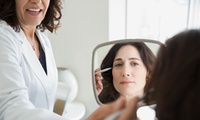GROUPON GUIDE TO SACRAMENTO
What Is Botox: The Complete Guide
BY: Editors |May 17, 2019
Botox Deals

0.5ml or 1ml Juvederm Ultra XC or 1ml Ultra Plus XC Syringe
1727 North Arizona Avenue, Chandler • 17.7 mi
Sale Ends 4/11
$234.09 with_code GROUPON
Beverlys Med Spa

Boost Your Lip Volume with 0.5 or 1ml Syringe of Juvederm Ultra XC
7125 South Val Vista Drive, Gilbert • 17.9 mi
Sale Ends 4/11
$225.99 with_code GROUPON
Injectaglo

Trending
Explore Wrinkle Solutions with Jeaveau and Lip Flip Options
15600 Hayden Road, Scottsdale • 24.8 mi
54% discount_off
$55.20 with_code GROUPON
Pure Benefits Aesthetics & Wellness

20 or 40 Units of Jeuveau for a Smoother Look
930 East Warner Road, Chandler • 16.9 mi
Sale Ends 4/11
$112.59 with_code GROUPON
Happy Juice IV And Beauty

Smooth Wrinkles with 100 or 50 Dysport Units or Versa Syringe
2268 East Williams Field Road, Gilbert • 13.2 mi
18% discount_off
Blurr Aesthetics

Experience the benefits of Jeuveau treatments at Fountain Hills Med Spa with options for 40 or 60 units, offering up to 35% off
16824 East Avenue of the Fountains, Fountain Hills • 16.3 mi
Sale Ends 4/11
$283.50 with_code GROUPON
Fountain Hills Med Spa

Achieve a New Look with 20 Units of Daxxify
1061 N Dobson Rd #110, Suite 5, Mesa • 18.2 mi
20% discount_off
Phoenix Medspa

Trending
Smooth Under-Eye Circles & Enhance Your Lips with Belotero & Restylane
2923 N 67th Pl., Scottsdale • 22.7 mi
Sale Ends 4/11
$305.37 with_code GROUPON
Derma Art Medspa

Get Fuller Lips With a Non-Surgical Lip Flip Treatment
4900 North Scottsdale Road, Scottsdale • 22.8 mi
Sale Ends 4/11
$76.95 with_code GROUPON
Vibrant Health Care

Get Jeuveau Injections with 20 or 40 Unit Options Available
4260 North Drinkwater Boulevard, Scottsdale • 22.3 mi
Sale Ends 4/11
$112.59 with_code GROUPON
Happy Juice IV And Beauty, LLC

Up to 10% Off on Injection - Filler and Freezer at DavLei Healing
5800 West Peoria Avenue, Glendale • 38.4 mi
10% discount_off
$180 with_code GROUPON
DavLei Healing

Rejuvenate with Dermal Fillers and More at Beverly's Med Spa
1727 North Arizona Avenue, Chandler • 17.7 mi
Sale Ends 4/11
$323.19 with_code GROUPON
Beverlys Med Spa

Up to 46% Off on Injection-Other-Dysport, Xeomin at Dolce Shine
2043 East Southern Avenue, Tempe • 20.2 mi
Sale Ends 4/11
$145.80 with_code GROUPON
Dolce Shine medspa

Advanced Aesthetic Techniques Jeuveau at 315 RX Med Spa
2735 South Alma School Road, Chandler • 20.5 mi
Sale Ends 4/11
$125.55 with_code GROUPON
2 bought
315 RX Med Spa

Kybella & Juvederm Injections for a Refreshed Look
2923 N 67th Pl., Scottsdale • 22.7 mi
Sale Ends 4/11
$400.95 with_code GROUPON
Derma Art Medspa
Other Injectables

Up to 30% Off on Injection-Other-Dysport, Xeomin at Absolute Beauty Company
4215 North Brown Avenue, Scottsdale • 22.3 mi
Sale Ends 4/11
$141.75 with_code GROUPON
Absolute Beauty Company

Up to 55% Off on Injection-Other-Dysport, Xeomin at REJALI MEDICAL LLC
10752 N 89th Place, SCottsdale • 22.8 mi
Sale Ends 4/11
$60.75 with_code GROUPON
Rejali Medical

Up to 49% Off on Injection-Other-Dysport, Xeomin at Skin Era
3303 South Lindsay Road, Gilbert • 15.5 mi
Sale Ends 4/11
$129.60 with_code GROUPON
Skin Era

Up to 46% Off on Injection-Other-Dysport, Xeomin at Dolce Shine
2043 East Southern Avenue, Tempe • 20.2 mi
Sale Ends 4/11
$145.80 with_code GROUPON
Dolce Shine medspa

Get a youthful look with up to 150 units of Dysport
15600 Hayden Road, Scottsdale • 24.8 mi
Sale Ends 4/11
$117.45 with_code GROUPON
Pure Benefits Aesthetics & Wellness

Transform Your Look with a Lip Flip Using Dysport
875 North Greenfield Road, Gilbert • 11.4 mi
Sale Ends 4/11
$56.70 with_code GROUPON
Drops of Beauty

0.5ml or 1ml Juvederm Ultra XC or 1ml Ultra Plus XC Syringe
1727 North Arizona Avenue, Chandler • 17.7 mi
Sale Ends 4/11
$234.09 with_code GROUPON
Beverlys Med Spa

20 or 40 Units of Xeomin at Peach Skin & Laser (Up to 50% Off)
1342 West Warner Road, Tempe • 24.4 mi
Sale Ends 4/11
$117.45 with_code GROUPON
Peach Skin & Laser - Tempe

Boost Your Lip Volume with 0.5 or 1ml Syringe of Juvederm Ultra XC
7125 South Val Vista Drive, Gilbert • 17.9 mi
Sale Ends 4/11
$225.99 with_code GROUPON
Injectaglo

Dysport Packages and Radiant Renewal Facial Options Available
1900 West Germann Road, Chandler • 21.0 mi
Sale Ends 4/11
$37.52 with_code GROUPON
Dolce Lounge Aesthetics and Wellness

Sculpt Your Cheeks or Enhance Lip Volume with Juvéderm Injections
1727 North Arizona Avenue, Chandler • 17.7 mi
Sale Ends 4/11
$323.19 with_code GROUPON
Beverlys Med Spa

Explore Wrinkle Solutions with Jeaveau and Lip Flip Options
15600 Hayden Road, Scottsdale • 24.8 mi
54% discount_off
$55.20 with_code GROUPON
Pure Benefits Aesthetics & Wellness

Up to 45% Off on Injection-Other-Dysport at Sachi Aesthetics
8370 East Vía de Ventura, Scottsdale • 22.4 mi
Sale Ends 4/11
$139.32 with_code GROUPON
Sachi Aesthetics

Revanesse Versa Lip Filler at Peach Skin & Laser (Up to 51% Off)
1342 West Warner Road, Tempe • 24.4 mi
53% discount_off
$303.20 with_code GROUPON
Peach Skin & Laser

20 or 40 Units of Jeuveau for a Smoother Look
930 East Warner Road, Chandler • 16.9 mi
Sale Ends 4/11
$112.59 with_code GROUPON
Happy Juice IV And Beauty











